جلسه دفاع دکتری مهندسی بهداشت محیط سرکار خانم مریم مرادنیا
جلسه دفاع دکتری تخصصی بهداشت محیط مریم مرادنیا از پایان نامه خود با عنوان "بررسی میانگین غلظت فلزات سنگین (آرسنیک، سرب، نیکل، کروم و سلنیوم) در ادرار زنان باردار و ارتباط میزان آنها با شاخص های تن سنجی نوزادان آنها در شهر اصفهان " با راهنمایی دکتر حسین موحدیان عطار و مشاوره دکتر رویاکلیشادی ، دکتر فرزانه محمدی و دکتر زهرا حیدری روز چهارشنبه 19 بهمن 1401در تالار میعاد دانشکده بهداشت دفاع نمودند.
Monitoring of urinary concentration of heavy metals(Arsenic,Lead, Chromium, Nickel and Selenium) in pregnant women of Isfahan and their association with anthropometric parameters of the subjected newborns
Abstract
Introduction: The increase in the use of heavy metals in many industrial, domestic, agricultural, medical, and technological uses has led to their widespread distribution in the environment and, as a result, increased concern about their potential effects on human health and the environment. This study aimed to evaluate the concentration of arsenic (As), lead (Pb), chromium (Cr), nickel (Ni) and selenium (Se) metals in the urine of pregnant women and the relationship between the levels of these metals with different lifestyle variables and anthropometric indices in Isfahan.
Methods: This study was a subset of the PERSIAN birth cohort study conducted in Isfahan. Urine samples were collected from 140 pregnant women living in Isfahan who were in their first trimester of pregnancy. The concentrations of heavy metals were measured by ICP-OES (Inductively coupled plasma-optical emission spectrometry). The socio-demographic and lifestyle were collected using PERSIAN birth cohort questionnaire.
Results: The mean concentration of As, Pb, Cr, Ni and Se were 8.14± 10.8, 9.6± 7.05, 7.5± 4.87, 3.87± 3.5 and 7.7±7.58 μg/g creatinine, respectively. The statistical results showed that the mean concentration of Pb, Cr and Ni in urine among those participants who used copper, aluminum alloys, teflon, steel containers, cosmetics users and women who were exposed to smoke and also had higher physical activity were significantly different with thier relevant groups (p-value<0.05). In addition, a significant difference was found between the mean urinary of Ni concentration with high consumption of canned foods and seafood compared to low and moderate consumption (p-value<0.05). Regression results also showed a significant negative association between Pb with head circumference in girls (p-value= 0.02) and As with birth weight in boys (p-value= 0.04) and a significant positive association between Cr with head circumference in girls (p-value= 0.03).
Conclusion: According to the obtained results, lifestyle variables, use of cosmetics and use of copper, aluminum alloys, teflon and steel containers were important predictors of higher amount of heavy metals in urine of pregnant women. Reduction in weight and PI were observed in infants whose mothers were exposed to higher amounts of Pb, Cr, and Ni.
Keywords: Heavy metals, Pregnant women, Anthropometric indices, Neonates




